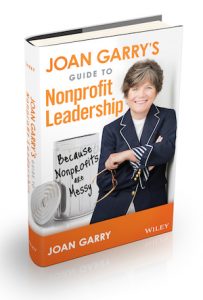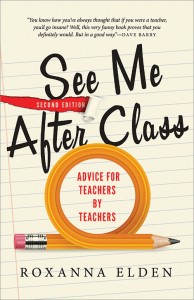We first met Joan Garry through Susan Weinberg, the publisher of Perseus Books Group. Joan was whip smart, pistol sharp, savvy, funny, altogether awesome, and shockingly humble. We would never have guessed that she is a top dog when it comes to consulting with nonprofits. And her website is of-the-charts excellent. It almost didn’t matter what her book was, we knew she had the goods necessary for success. Now that her book Joan Garry’s Guide to Nonprofit Leadership is out, we wanted to pick her brain about books, writing, and nonprofits.
Read this interview on the HuffPost.

Joan Garry
The Book Doctors: There are other books on the subject of nonprofit management. Without an apparent hole in the market, how did you distinguish your book from what was already out there?
Joan Garry: You’re absolutely right – there are plenty of books about nonprofit management, but none that focus on what I call “shared leadership,” which is a challenge and opportunity quite unique to nonprofits.
What I mean is, there are books written for staff executives and resources galore for board leaders. But the reality is neither can be effective without the other. Nobody else has written about them as co-pilots of the same jet. If we don’t treat board chairs like they are in the cockpit, they won’t lead. This book is written for nonprofit leaders – the paid AND the unpaid.
I also found that a number of important topics were conspicuously absent. For example, storytelling plays an absolutely critical role in successful nonprofit leadership. A nonprofit ambassador who can tell a compelling and emotional story can invite folks to know more and do more. Crisis management is another missing topic. Far too few organizations are ready should a crisis strike.
Finally, I tried to bring a real sense of humor to the book. A lot of the book touches on personal experiences I had as a nonprofit Executive Director, a board leader, a donor, and a volunteer. I just had so many great stories to share and these stories are what make the book unique and fun to read – not just practical, though it is that too.
TBD: One thing about your book that’s different from the others out there is your voice. Why is the voice of your book important? For others writing books based on their business, what advice can you offer about bringing your voice into your book?
JG: I’m lucky. I write the way I speak and so folks say reading my work is like hearing me chat with them. My voice is informed by having played every position on the nonprofit field, so I have stood firmly in the shoes of my readers. I have personally experienced many of the same issues and concerns they have – good and bad.
Most nonprofit leadership books tend to be pretty clinical and instructive. That’s not necessarily a bad thing, but that’s not the book I wanted to write. I wanted to demonstrate the joy that the best leaders bring to their work. And it’s a short ride from joy to humor. And there’s plenty of humor in my book. I just think that makes it a lot more fun to read, which ultimately makes it easier to absorb the material.

WILEY
TBD: You have an incredible team that works with you. How did this team help you get your proposal, book, and your marketing done? Why is it important to have a team?
JG: Some people have a family business – I call mine a ‘chosen family business’ – a small team of colleagues who are smart and dedicated to the work we do. Each of us is clear that we are advocates for the success of nonprofit leaders and we always keep our eye on what we believe would be most helpful to the folks we serve – staff and board leaders. We each brought something different to the development of the book proposal to chapter editing to marketing the book. The brand, the audience, the strategy to reach that particular audience, the content. Each of us were advocates in each of these areas. There’s no way I could have done all this by myself.
TBD: When we first met you, we were really struck by your website. We’ve continued to be so impressed by all your social media — particularly your newsletters. How did you develop your digital platform? What are some things that have worked, and what are some things that haven’t?
JG: I started to build my digital platform in late 2012. One of the best business decisions I ever made was hiring my digital strategist, Scott Paley at Abstract Edge. When I first reached out to him, based on a recommendation I got from somebody else who had worked with his company, I told him I needed a new website for my consulting business. That’s all I thought I needed. What did I know? In our very first conversation, he gave me a vision for what could be – a much bigger vision that I had imagined.
That conversation ultimately led to my blog, my social media, my podcast, my gig as a panelist on NBC’s Give (the first network TV reality show about nonprofits), my upcoming online education platform, and even the opportunity to have a major publisher interested in publishing my book. Now, whenever I write something online, tens of thousands of people read it! Not surprisingly, my consulting practice completely took off. It’s just amazing.
The biggest thing about this platform is that I just focus on helping people. I recently had Adam Grant on the podcast. He’s the author of a best selling book that’s all about “givers” and “takers”. His philosophy has been a big influence. Everything I do online is about giving. I never worry that I’m giving away too much. I really think that’s been the secret.
Most of what we’ve tried has worked very well. The one exception was a couple years ago we built an area on my website called “The Couch.” It was a place where nonprofit people could anonymously vent about their frustrations and others could sympathize. After a couple of months, we realized that it was too negative and we shut it down. But I don’t view that as a failure at all. It taught us a lot about what “Joan Garry” stands for as a brand and how important it is for all of our media to be on brand.
TBD: What did you find challenging about turning your business into a book?
JG: So much of what I do with my clients is teach. I’m an educator. I think writing the book was easier for me because of that and because of how much I’ve already written on my blog. The blog is a place where I can formulate my ideas and get them down in writing and get feedback from literally thousands of people who understand exactly what I’m writing about. The blog is an amazing crucible for me in that sense and the outcome of all that thinking and all that feedback is this book. Without that, it certainly would have been much more challenging to write.
TBD: Did you find that writing a book helped you with your business?
JG: I’ll let you know in about 6-9 months. J
But I will say that the process of writing the book has helped me to organize some of what I teach my clients in new ways I hadn’t previously considered. So in that sense, absolutely it has helped.
TBD: Your book is officially published on March 6, but you’ve been so successful in garnering pre-orders. Can you tell us a little bit about how you did this?
JG: Largely this was also the work of Scott, my digital strategist, and his team at Abstract Edge. They created a gorgeous website for the book (www.nonprofitsaremessy.com), but more importantly they put together a plan that really leveraged the audience we’ve built up over the last 4 years.
We’re offering valuable book bonuses for pre-orders. We developed a really smart rollout strategy that includes the blog, the podcast, my email list, and social media. We organized a volunteer “launch team” to help spread the word. Created a Thunderclap, which will help spread the word even further on launch day. We’ve given copies of the book to some well-known folks in the nonprofit world who are saying lovely things about it and telling their networks. All of that has led to a much larger volume of pre-sales than the publisher was initially anticipating.
I’ve been absolutely thrilled by the response.
TBD: We hate to ask you this, but what advice do you have for writers?
- Make sure you have something unique to say and can say it in a way that sticks.
- Be absolutely clear about who you are speaking to and be as specific as possible. You have to really understand your readers’ concerns and issues.
- Be passionate about ensuring that the maximum number of those people have the opportunity to buy it. And be ready to invest time, energy and money in reaching them.
Widely known as the “Dear Abby” of nonprofit leadership, Joan Garry works with nonprofit CEOs and boards as a strategic advisor, crisis manager, change agent and strategic planner. Her nonprofit blog at joangarry.com reaches leaders in over 150 countries and she hosts a top nonprofit podcast on iTunes: Nonprofits Are Messy. Joan also teaches at the University of Pennsylvania with a focus on nonprofit communications and leadership.
Arielle Eckstut and David Henry Sterry are co-founders of The Book Doctors, a company that has helped countless authors get their books published. They are co-authors of The Essential Guide to Getting Your Book Published: How To Write It, Sell It, and Market It… Successfully (Workman, 2015). They are also book editors, and between them they have authored 25 books, and appeared on National Public Radio, the London Times, and the front cover of the Sunday New York Times Book Review.



